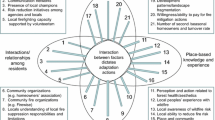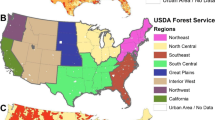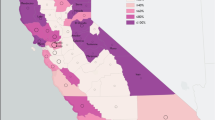Abstract
A large body of research focuses on identifying patterns of human populations most at risk from hazards and the factors that help explain performance of mitigations that can help reduce that risk. One common concept in such studies is social vulnerability—human populations’ potential exposure to, sensitivity from and ability to reduce negative impacts from a hazard. While there is growing interest in social vulnerability for wildfire, few studies have critically evaluated the characteristics that scholars often indicate influence social vulnerability to that hazard. This research utilizes surveys, wildfire simulations, and GIS data to test the relationships between select demographic, perceptual and parcel characteristics of property owners against empirically simulated metrics for wildfire exposure or wildfire-related damages and their performance of mitigation actions. Our results from Flathead County, MT, USA, suggest that parcel characteristics such as property value, building value, and the year structures were built explaining a significant amount of the variance in elements of social vulnerability. Demographic characteristics commonly used in social vulnerability analysis did not have significant relationships with measures of wildfire exposure or vulnerability. Part-time or full-time residency, age, perceived property risk, and year of development were among the few significant determinants of residents’ performance of fuel reduction mitigations, although the significance of these factors varied across the levels of fuel reduction performed by homeowners. We use these and other results to argue for a renewed focus on the finer-scale characteristics that expose some populations to wildfire risk more than others.
Similar content being viewed by others
References
Ager AA, Kline JD, Fischer AP (2015) Coupling the biophysical and social dimensions of wildfire risk to improve wildfire mitigation planning. Risk Anal 35(8):1393–1406
Andrey J, Jones B (2008) The dynamic nature of social disadvantage: implications for hazard exposure and vulnerability in Greater Vancouver. Can Geogr 52(2):146–168
Anton CE, Lawrence C (2016) Does place attachment predict wildfire mitigation and preparedness? A comparison of wildland–urban interface and rural communities. Environ Manage 57:148–162
Calkin DE, Cohen JD, Finney MA, Thompson MP (2014) How risk management can prevent future wildfire disasters in the wildland–urban interface. Proc Natl Acad Sci USA 111(2):746–751
Carroll MS, Cohn PJ, Seesholtz DN, Higgins L (2005) Fire as a galvanizing and fragmenting influence on communities: the case of the Rodeo-Chediski Fire. Soc Nat Resour 18(4):301–320
Charnley S, Poe MR, Ager AA, Spies TA, Platt EK, Olsen KA (2015) A burning problem: social dynamics of disaster risk reduction through wildfire mitigation. Hum Organ 74(4):329–340
Cohen J, Cohen P, West SG, Aiken LS (2003) Applied multiple regression/correlation analysis in the behavioral sciences, 3rd edn. Lawrence Erlbaum Associates, Mahwah
Collins TW (2008) The political ecology of hazard vulnerability: marginalization facilitation and the production of differential risk to urban wildfires in Arizona’s White Mountains. J Polit Ecol 15:21–43
Collins TW (2009) Influences on wildfire hazard exposure in Arizona’s high country. Soc Nat Resour 22:211–229
Collins T (2012) A landscape typology of residential wildfire risk. In: Paton D, Tedim F (eds) Wildfire and community: facilitating preparedness and resilience. Charles C. Thomas, Springfield, pp 3–65
Cutter SL, Boruff BJ, Shirley WL (2003) Social vulnerability to environmental hazards. Soc Sci Q 84(2):242–261
Cutter SL, Barnes L, Berry M, Burton C, Evans E, Tate E, Webb J (2008) A place-based model for understanding community resilience to natural disasters. Glob Environ Change 18:598–606
Dickinson K, Brenkert-Smith H, Champ P, Flores N (2015) Catching Fire? Social interactions, beliefs, and wildfire risk mitigation behaviors. Soc Nat Resour 28:807–824
Dillman DA, Smyth JD, Christian LM (2009) Internet, mail and mixed-mode surveys: the tailored design. Wiley, Hoboken
Finney MA, Grenfell IC, McHugh CW, Seli RC, Trethewey D, Stratton RD, Brittain S (2011) A method for ensemble wildland fire simulation. Environ Model Assess 16:153–167
Fischer AP, Paveglio TB, Carroll MS, Brenkert-Smith H, Murphy DJ (2013) Assessing social vulnerability to climate change in rural communities near public lands: elements of a framework for managers. J For 111(5):357–365
Fischer AP, Kline JD, Ager AA, Charnley S, Olsen KA (2014) Objective and perceived wildfire risk and its influence on private forest landowners’ fuel reduction activities in Oregon’s ponderosa pine ecoregion. Int J Wildland Fire 23:143–153
Flint CG, Luloff AE (2005) Natural resource-based communities, risk and disaster: an intersection of theories. Soc Nat Resour 18(5):399–412
Ford JD, Pearce T, Duerden F, Furgal C, Smit B (2010) Climate change policy responses for Canada’s Inuit population: the importance of and opportunities for adaptation. Glob Environ Change 16(2):145–160
Gaither CJ, Poudyal NC, Goodrick S, Bowker JM (2011) Wildfire risk and social vulnerability in the Southeastern United States: an exploratory spatial data analysis approach. For Policy Econ 13:24–36
Gaither JG, Goodrick S, Murphy BE, Poudyal N (2015) An exploratory spatial analysis of social vulnerability and smoke plume dispersion in the U.S. South. Forests 6:1397–1421
Gude PH, Jones K, Rasker R, Greenwood MC (2013) Evidence for the effect of homes on wildfire suppression costs. Int J Wildland Fire 22:537–548
Haas JR, Calkin DE, Thompson MP (2014) Wildfire risk transmission in the Colorado Front Range, USA. Risk Anal 35(2):226–240
Kanclerz L, Dechano-Cook LM (2013) Understanding wildfire vulnerability of residents in Teton County, Wyoming. Disaster Prev Manag 22(2):104–118
Keane RE, Loehman RA, Holsinger LM (2011) The FireBGCv2 landscape fire succession model: a research simulation for exploring fire and vegetation dynamics. General Technical Report, RMRS-GTR-255. USDA Forest Service, Rocky Mountain Research Station, Fort Collins, CO
Krietler J, Wood N, Valliant N, Schmidtlein M (2015) Vulnerability and ecosystem services in wildfire risk assessments and fuel treatment planning. JFSP final report. http://www.firescience.gov/JFSP_funded_project_detail.cfm?jdbid=%24%26ZO9T0%20%20%0A
Liu Z, Wimberly MC, Lamsal A, Sohl TL, Hawbaker TJ (2015) Climate change and wildfire risk in an expanding wildland—urban interface: a case study from the Colorado Front Range Corridor. Landscape Ecol 30(10):1943–1957
Lynn K (2003) Wildfire and rural poverty: disastrous connections. Nat Hazards Obs 29:10–11
Mann ML, Berck P, Moritz MA, Batllori E, Baldwin JG, Gately CK, Cameron DR (2014) Modeling residential development in California from 2000 to 2050: integrating wildfire risk, wildland and agricultural encroachment. Land Use Policy 41:438–452
Martin IM, Bender H, Raish C (2007) What motivates individuals to protect themselves from risk: the case of wildland fires. Risk Anal 27(4):887–899
McCaffrey S (2015) Community wildfire preparedness: a global state-of-the-knowledge summary of social science research. Curr For Rep 1:81–90
McCaffrey S, Toman E, Stidham M, Shindler B (2013) Social science research related to wildfire management: an overview of recent findings and future research needs. Int J Wildland Fire 22:15–24
McCullagh P, Nelder JA (1989) Generalized linear models, 2nd edn. Chapman & Hall, New York
Meldrum JR, Champ PA, Warziniack T, Brenkert-Smith H, Barth CM, Falk LC (2014) Cost shared wildfire risk mitigation in Log Hill Mesa, Colorado: survey evidence on participation and willingness to pay. Int J Wildland Fire 23:567–576
Mercer DE, Prestemon JP (2005) Comparing production function models for wildfire risk analysis in the wildland–urban interface. For Policy Econ 7(5):782–795
Montana Cadastral (2010). http://svc.mt.gov/msl/mtcadastral
Murphy D, Wyborn C, Yung L, Williams DR (2015) Key concepts and methods in social vulnerability and adaptive capacity. Gen Tech. Rep. RMRS-GTR-328. Fort Collins, CO: U.S. Department of Agriculture, Forest Service, Rocky Mountain Research Station. 24 p
Nielsen-Pincus M, Ribe R, Johnson BR (2015) Spatially and socially segmenting private landowner motivations, properties, and management: a typology for the wildland urban interface. Land Urban Plan 137:1–12
Norris F, Stevens S, Pfefferbaum B, Wyche K, Pfefferbaum R (2008) Community resilience as a metaphor, theory set of capacities, and strategy for disaster readiness. Am J Community Psychol 41(1):127–150
Ojerio R, Moseley C, Lynn K, Bania N (2011) Limited involvement of socially vulnerable populations in federal programs to mitigate wildfire risk in Arizona. Nat Hazards Rev 12(1):28–36
Paveglio TB, Prato T, Hardy M (2013) Simulating effects of land use policies on extent of the wildland–urban interface and wildfire risk in Flathead County, Montana. J Environ Manag 130(3):20–31
Paveglio TB, Prato T, Dalenberg D, Venn T (2014) Understanding evacuation preferences and wildfire mitigations among Northwest Montana residents. Int J Wildland Fire 23(3):435–444
Paveglio TB, Moseley C, Carroll MS, Williams DR, Fischer AP, Davis EJ (2015a) Categorizing the social context of the wildland urban interface: adaptive capacity for wildfire and community “archetypes”. For Sci 61(2):298–310
Paveglio TB, Brenkert-Smith H, Hall T, Smith AS (2015b) Understanding social impact from wildfires: advancing means for assessment. Int J Wildland Fire 24(2):212–224
Phillips BD, Morrow BH (2007) Social science research needs: focus on vulnerable populations, forecasting, and warnings. Nat Hazards Rev 8(3):61–68
Platt RV (2010) The wildland–urban interface: evaluating the definition effect. J Forest 108(1):9–15
Platt RV, Schoennagel T, Veblen TT, Sherriff RL (2011) Modeling wildfire potential in residential parcels: a case study of the north-central Colorado front range. Land Urban Plan 102:117–126
Poudyal NC, Johnson-Gaither C, Goodrick S, Bowker JM, Gan J (2012) Locating spatial variation in the association between wildland fire risk and social vulnerability across six southern states. Environ Manage 49:623–635
Prato T, Paveglio TB (2014) An integrated conceptual framework for adapting forest management practices to alternative futures. Int J For Res 2014, Article ID 321345. doi:10.1155/2014/321345
Prato T, Paveglio TB, Barnett Y, Silverstein R, Hardy M, Keane R, Loehman R, Clark A, Fagre D, Venn T, Stockmann K (2014) Simulating future residential property losses from wildfire in Flathead County, Montana. In: Daniels J (ed) Advances in environmental science, vol 33. Nova Science Publishers, Inc., Hauppauge
Preston BL, Brook C, Measham TG, Smith TF, Goddard R (2009) Igniting change in local government: lessons learned from a bushfire vulnerability assessment. Mitig Adapt Strat Glob Change 14:251–283
Ramsey FL, Schafer DW (2013) The statistical sleuth: a course in methods of data analysis, 3rd edn. Brooks/Cole, Boston
Smith MS, Kolden CA, Paveglio TB, Cochrane MA, Bowman D, Moritz MA, Kliskey AD et al (2016) The science of firescapes: achieving fire-resilient communities. Bioscience 66(2):130–146
Solangaarachchi D, Griffin AL, Doherty MD (2012) Social vulnerability in the context of bushfire risk at the urban-bush interface in Sydney: a case study of the Blue Mountains and Ku ring-gai local council areas. Nat Hazards 64:1873–1898
Stetler KM, Venn TJ, Calkin DE (2010) The effects of wildfire and environmental amenities on property values in northwest Montana, U.S. Ecol Econ 69:2233–2243
Stewart SI, Radeloff VC, Hammer RB, Hawbaker TJ (2007) Defining the wildland–urban interface. J Forest 105(4):201–207
Stewart SI, Wilmer B, Hammer RB, Aplet GH, Hawbaker TJ, Miller C, Radeloff VC (2009) Wildland–urban interface maps vary with purpose and context. J Forest 107:78–83
Stockmann K, Burchfield J, Calkin D, Venn T (2010) Guiding preventative wildland fire mitigation policy and decisions with an economic modeling system. For Policy Econ 12(2):147–154
Tedim F (2012) Enhance wildfire risk management in Portugal: the relevance of vulnerability assessment. In: Paton D, Tedim F (eds) Wildfire and community: facilitating preparedness and resilience. Charles C. Thomas, Springfield, pp 3–65
Thompson MP, Haas JR, Gilbertson-Day JW, Scott JH, Langowski P, Bowne E, Calkin DE (2015) Development and application of a geospatial wildfire exposure and risk calculation tool. Environ Model Softw 63:61–72
Toman E, Melanie S, McCaffrey S, Shindler B (2013) Social science at the wildland–urban interface: a compendium of research results to create fire-adapted communities. General technical report no. NRS-GTR-11. US Department of Agriculture Forest Service
Wildland Fire Executive Council (WFEC) (2014) The national strategy: the final phase in the development of the National Cohesive Wildland Fire Management Strategy. http://www.forestsandrangelands.gov/leadership/WFEC/index.shtml
Acknowledgments
Partial funding for this research came from the National Science Foundation (awards 0903562 and 1520873) and the USDA National Institute of Food and Agriculture (award IDAZ-MS-0107).
Author information
Authors and Affiliations
Corresponding author
Rights and permissions
About this article
Cite this article
Paveglio, T.B., Prato, T., Edgeley, C. et al. Evaluating the Characteristics of Social Vulnerability to Wildfire: Demographics, Perceptions, and Parcel Characteristics. Environmental Management 58, 534–548 (2016). https://doi.org/10.1007/s00267-016-0719-x
Received:
Accepted:
Published:
Issue Date:
DOI: https://doi.org/10.1007/s00267-016-0719-x




